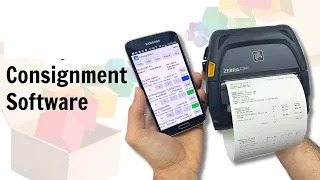
What is consignment in the DSD and Distribution Industry?
Last week I wrote about the Scan Based Trading model as compared to the traditional DSD model. This week I am going to address another trade practice called Consignment. I will explore its pros and cons, how it differs from Scan Based Trading, and why you need Consignment Software if you adopt this practice.
What is Consignment?
The Corporate Financial Institute defines Consignment sales as a trade agreement in which one party (the distributor, DSD, or manufacturer) provides goods to another party (the stores) to sell. The customer is invoiced on subsequent visits only when the products are sold and he has the right to return unsold goods to the consigner.
How does the Consignment sales model work?
Consignment means that you leave the product at the customer’s point of sale and you do not charge the customer for it. After a certain period of time defined in the “Consignment Agreement,” you pay the customer a second visit and count what is left on display. The difference is then invoiced to the customer. If the quantity sold is small compared to the amount on display, it means that you are overstocking the store and credits will soar. On the other hand, running out of stock in the store means that you are underselling. So, good Consignment software will allow you to minimize store credits, optimize inventory and increase gross profit.
Pros of Consignment for the distributor
If you read my previous post on Scan Based Trading you can see that Consignment is pretty similar to SBT. As such, most of the advantages of SBT apply to Consignment. Let-s review them.
Increased sales and numeric distribution
With Consignment, as with scan-based trading, since the customer does not run the risk of buying something that does not sell, they are more prone to accept new products with good records in other stores. This gives an excellent opportunity to the distributor to raise sales by increasing the number of products in the stores.
Reduction in non-sellable products and optimized product mix
A well-managed Consignment policy can give you forecasting and sales information so that you can understand how certain products are moving in each store. With that information, you can decide what the optimal quantity per store per product is. This will reduce credits due to improving product rotation.
No shrinkage risks
Even though with Consignment the inventory in the store belongs to the distributor or manufacturer, the sales are based on the calculation of the initial inventory minus the ending inventory. So, if someone stole products from the store, the shrinkage would be the store’s responsibility.
Cons of Consignment
There are not many cons associated with a consignment sales model. I can just pinpoint these two.
Out of sight, out of mind
Given that the store does not lose anything by a consigned product that does not sell well, they might not give enough promotion or visibility to such products. Stores may be more inclined to give precedence to merchandise which they have outright ownership of, rather than the goods you have sold to them on a consignment basis.
The complexity of managing consigned inventory
Most of the benefits outlined above rely on tight control of the consigned inventory. Unless you have sound Consignment software you will not be able to track the flow of the consigned inventory and as a result, you will not benefit from this trade model.
Consignment vs Scan Based Trading
Consignment and SBT are similar in the sense that the owner of the product in the stores is the supplier. However, the key difference between them is how they determine the quantity sold of a given product in the store. In Scan Based Trading, an item is considered as sold when it is scanned by the cashier, whereas in Consignment, the difference between the initial store’s inventory and the inventory in the second visit is the number of products considered sold. This conceptual difference impacts the distributor in three ways:
Control of sales
In scan-based trading, the sales are determined by the store, and a third party is required to mediate between the stores’ cash register and the vendor. In Consignment, the sales are determined by the suppliers’ vendor, so that they have total control of the process and no middlemen are required.
When does the supplier get paid?
In SBT the supplier gets paid by the SBT provider at the frequency determined in their agreement. In a consignment model, the invoice is issued during the visit and the supplier gets paid directly by the store on the basis established between the supplier and each store.
Responsibility for the shrinkage
With scan-based trading, the supplier is responsible for the Shrinkage while with Consignment, Shrinkage is the responsibility of the store.
What is a Consignment Software?

Consignment Software is a computer program or Mobile Application that stores information about a consignment business and which performs related tasks like inventory management, sales and settlements processing, and the printing of agreements, price labels and reports. This system integrates with the accounting system of the company.
How can you implement a successful Consignment model?
It should be clear by now that you should not engage in a Consignment policy without Consignment DSD software with the following features:
Manage Store Consigned Inventory
The Consignment software should show the driver everything that is on consignment in every store. The driver will be able to use the app to review the Consignment history with that customer and how the Consignment levels have fluctuated over time to keep up with the demand in the store.
Set Consigned Levels
Consignment software should allow the driver or sales rep to create and change consignment levels for any customer. If a customer is moving more units than expected, you can then increase the consignment level. If the product is not selling well, you’ll be able to decrease the consignment level.
Invoicing at the store
Invoices are automatically generated by the Consignment software and they should contain the items sold, the old and new consignment quantities, the replenished quantities, and a current copy of the consignment contract or agreement. The software should allow to collect signatures and print them using a thermal printer. All this information has to be sent to the back office.
Keep track of overall Consignment inventory
No ERP system automatically tracks consigned inventory. This is because products left on consignment do not require entry into the accounting system. The only way to track consigned inventory within an ERP system is to hand key thousands of transactions tracking the inventory movements on and off the truck, which is neither accurate nor efficient. Consignment DSD software records all these inventory movements automatically and exports them directly to the ERP when the driver ends their route for the day.
I hope this article has been helpful. I will continue to publish information related to Warehouse Management and distribution practices. If you are interested in this article or want to learn more about Laceup Solutions, register to keep you updated on future articles.
Laceup’s Consignment DSD software has all the features you need. If you want to know more about how it works, take a look at this video.


Sorry, the comment form is closed at this time.